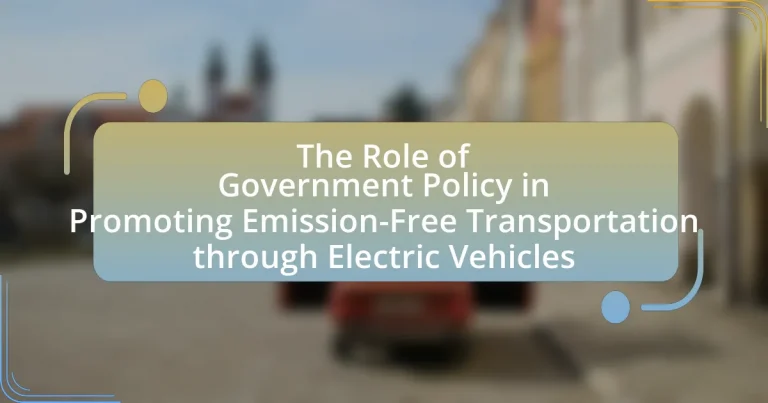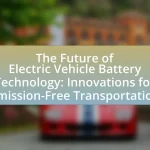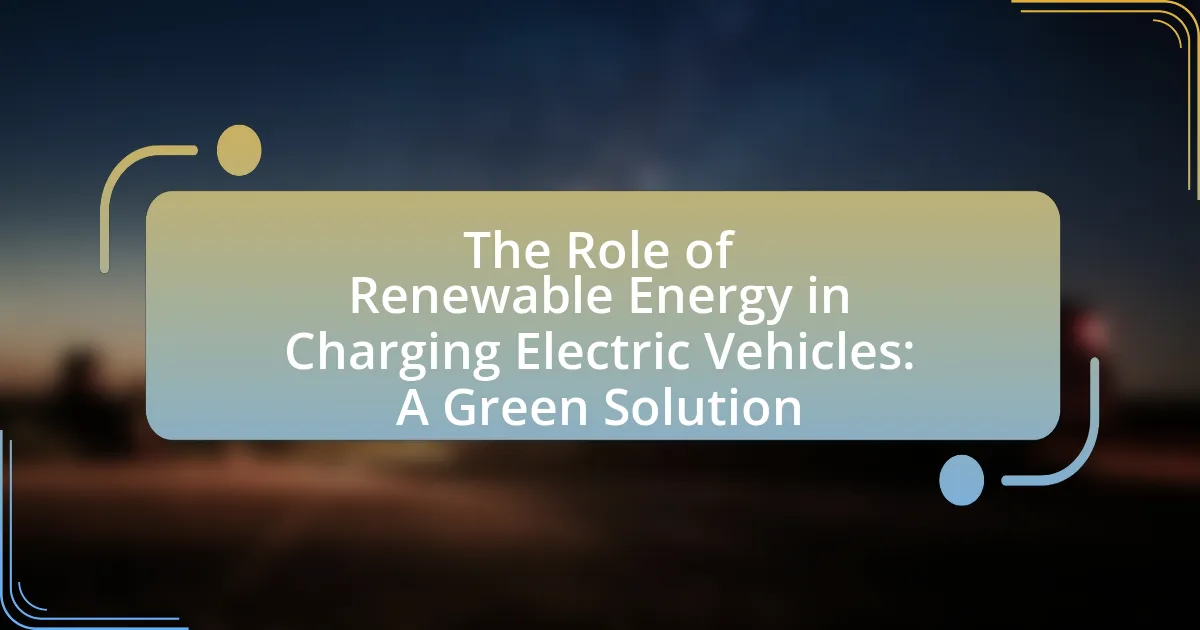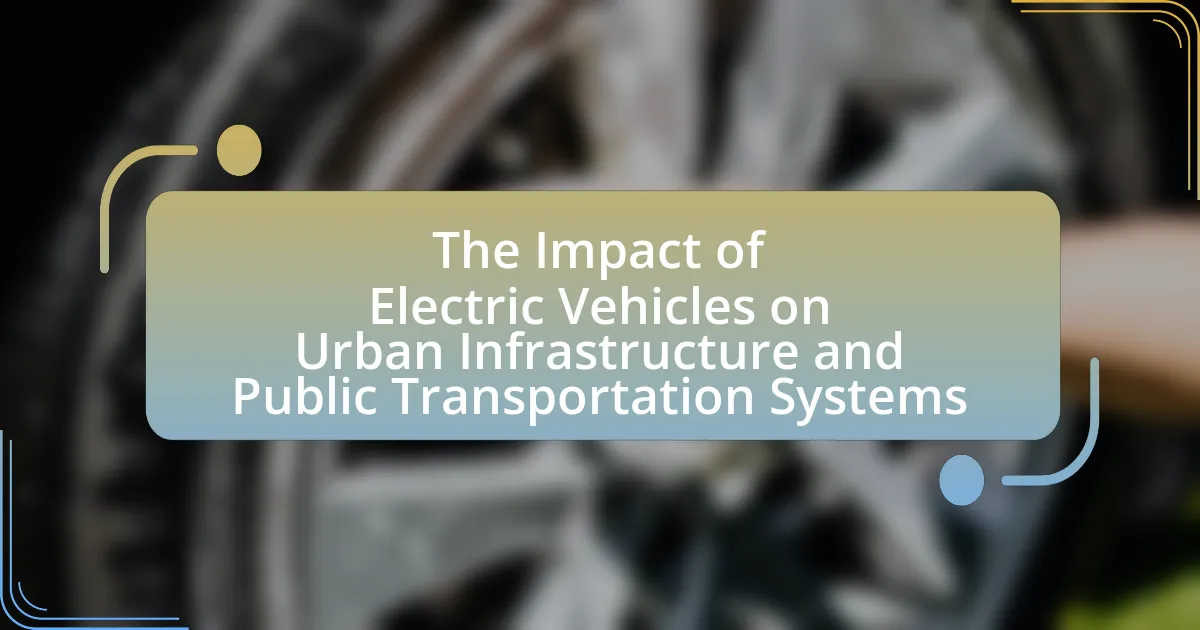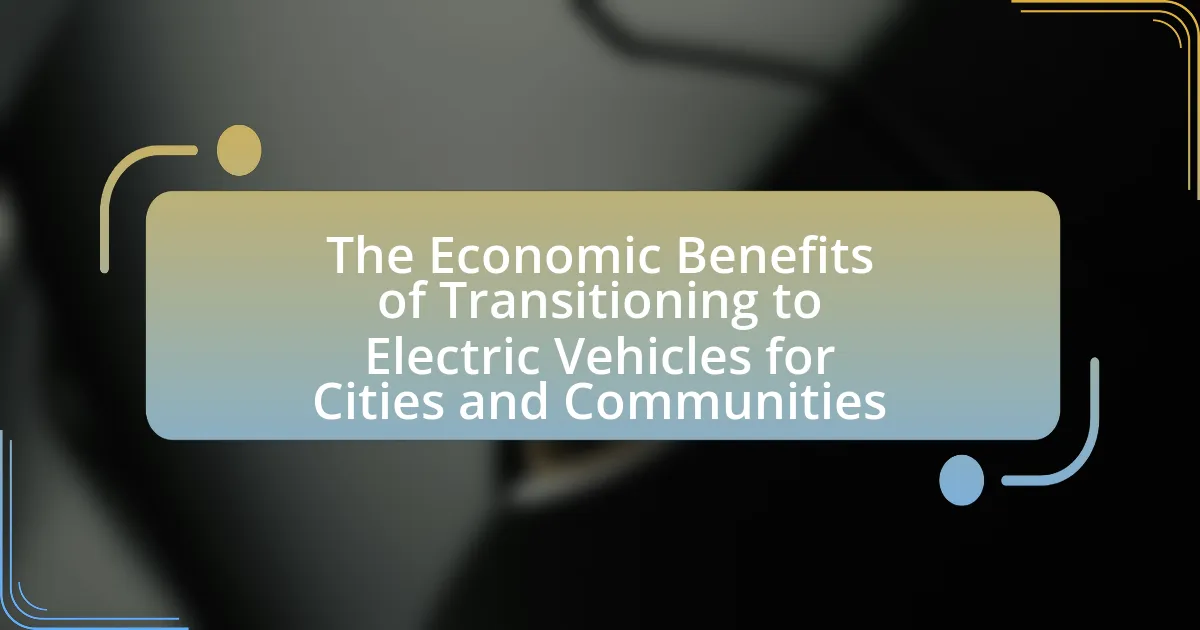The article examines the critical role of government policy in promoting emission-free transportation through electric vehicles (EVs). It highlights how regulations, financial incentives, and infrastructure development drive the adoption of EVs, reduce greenhouse gas emissions, and support a sustainable transportation ecosystem. Key components discussed include tax credits, charging infrastructure investments, and regulatory frameworks that compel manufacturers to produce more electric vehicles. The article also explores the environmental benefits of transitioning to EVs, the necessity of government intervention, and best practices for designing effective incentive programs to enhance consumer adoption.

What is the Role of Government Policy in Promoting Emission-Free Transportation through Electric Vehicles?
Government policy plays a crucial role in promoting emission-free transportation through electric vehicles by implementing regulations, incentives, and infrastructure development. Policies such as tax credits for electric vehicle purchases, grants for charging station installations, and emissions standards encourage consumers and manufacturers to adopt electric vehicles. For instance, the U.S. federal government offers a tax credit of up to $7,500 for electric vehicle buyers, which has significantly increased sales. Additionally, government investments in charging infrastructure, such as the $7.5 billion allocated in the Bipartisan Infrastructure Law, facilitate the transition to electric vehicles by making them more accessible. These policies collectively drive market demand, reduce greenhouse gas emissions, and support the development of a sustainable transportation ecosystem.
How do government policies influence the adoption of electric vehicles?
Government policies significantly influence the adoption of electric vehicles by providing financial incentives, establishing regulatory frameworks, and investing in infrastructure. Financial incentives, such as tax credits and rebates, lower the upfront costs for consumers, making electric vehicles more attractive; for example, the U.S. federal tax credit offers up to $7,500 for eligible electric vehicle purchases. Regulatory frameworks, including emissions standards and fuel economy regulations, compel manufacturers to produce more electric vehicles, as seen in California’s Zero Emission Vehicle program, which mandates a certain percentage of sales to be electric. Additionally, government investment in charging infrastructure enhances accessibility, as evidenced by the expansion of charging stations under initiatives like the U.S. Department of Energy’s Alternative Fuels Data Center, which supports the growth of electric vehicle adoption by alleviating range anxiety among consumers.
What types of government policies are most effective in promoting electric vehicle use?
Government policies that are most effective in promoting electric vehicle use include financial incentives, infrastructure development, and regulatory measures. Financial incentives, such as tax credits and rebates for electric vehicle purchases, have been shown to significantly increase adoption rates; for instance, the U.S. federal tax credit of up to $7,500 has encouraged many consumers to choose electric vehicles. Infrastructure development, particularly the expansion of charging networks, is crucial as it alleviates range anxiety among potential buyers; studies indicate that regions with more charging stations see higher electric vehicle sales. Regulatory measures, such as emissions standards and zero-emission vehicle mandates, compel manufacturers to produce more electric vehicles, thereby increasing market availability and consumer choice; California’s mandate for a certain percentage of sales to be zero-emission vehicles is a prime example of this approach.
How do subsidies and incentives impact consumer choices regarding electric vehicles?
Subsidies and incentives significantly influence consumer choices regarding electric vehicles by reducing the overall cost of purchase and ownership. Financial incentives, such as tax credits and rebates, lower the initial price, making electric vehicles more accessible to a broader audience. For instance, in the United States, the federal tax credit can provide up to $7,500 off the purchase price of an electric vehicle, which has been shown to increase sales and adoption rates. Additionally, subsidies for charging infrastructure and reduced registration fees further enhance the attractiveness of electric vehicles, leading to a higher likelihood of consumers choosing them over traditional gasoline-powered cars. Studies indicate that regions with robust incentive programs see a marked increase in electric vehicle registrations, demonstrating the direct correlation between government financial support and consumer purchasing behavior.
Why is government intervention necessary for emission-free transportation?
Government intervention is necessary for emission-free transportation to accelerate the transition to electric vehicles and reduce greenhouse gas emissions. This is crucial because the private sector often lacks the incentive to invest in the high upfront costs of electric vehicle infrastructure and technology without government support. For instance, subsidies and tax incentives can lower the purchase price of electric vehicles, making them more accessible to consumers. According to a report by the International Council on Clean Transportation, countries that implemented strong government policies, such as Norway, saw electric vehicle market shares rise to over 54% in 2020, demonstrating the effectiveness of intervention in promoting cleaner transportation options.
What are the environmental benefits of transitioning to electric vehicles?
Transitioning to electric vehicles (EVs) significantly reduces greenhouse gas emissions, contributing to improved air quality and lower global warming potential. EVs produce zero tailpipe emissions, which decreases pollutants such as nitrogen oxides and particulate matter, leading to healthier urban environments. According to the U.S. Environmental Protection Agency, transportation accounts for approximately 29% of total greenhouse gas emissions in the United States, and shifting to EVs can help mitigate this impact. Additionally, studies indicate that the lifecycle emissions of EVs are lower than those of conventional vehicles, even when considering the emissions from electricity generation. This transition supports sustainable energy practices and aligns with global efforts to combat climate change.
How do government policies address the challenges of climate change through electric vehicle promotion?
Government policies address the challenges of climate change through electric vehicle promotion by implementing incentives, regulations, and infrastructure development. These policies include tax credits for electric vehicle purchases, which encourage consumers to choose electric over traditional gasoline vehicles, thereby reducing greenhouse gas emissions. For instance, the U.S. federal government offers a tax credit of up to $7,500 for eligible electric vehicles, significantly lowering the cost barrier for consumers. Additionally, many governments enforce stricter emissions standards for automakers, compelling them to invest in electric vehicle technology. Furthermore, the establishment of charging infrastructure, supported by government funding, facilitates the adoption of electric vehicles by alleviating range anxiety among potential users. Collectively, these measures contribute to a decrease in carbon emissions and promote a transition to sustainable transportation solutions.
What are the key components of effective government policies for electric vehicles?
Effective government policies for electric vehicles include financial incentives, infrastructure development, regulatory frameworks, and public awareness campaigns. Financial incentives, such as tax credits and rebates, encourage consumers to purchase electric vehicles, evidenced by the U.S. federal tax credit of up to $7,500 for eligible electric vehicle buyers. Infrastructure development focuses on expanding charging networks, which is crucial as studies show that access to charging stations significantly influences consumer adoption rates. Regulatory frameworks, including emissions standards and fuel economy regulations, drive manufacturers to produce more electric vehicles, as seen in California’s Zero Emission Vehicle program. Lastly, public awareness campaigns educate consumers about the benefits of electric vehicles, contributing to increased acceptance and demand.
How do regulations and standards shape the electric vehicle market?
Regulations and standards significantly shape the electric vehicle market by establishing requirements for vehicle emissions, safety, and performance. These regulations, such as the Corporate Average Fuel Economy (CAFE) standards in the United States, mandate that automakers improve fuel efficiency and reduce greenhouse gas emissions, thereby incentivizing the production of electric vehicles. Additionally, standards set by organizations like the International Organization for Standardization (ISO) ensure compatibility and safety in electric vehicle technology, fostering consumer confidence and market growth. For instance, the European Union’s stringent emissions targets have led to a surge in electric vehicle sales, with a reported increase of 137% in 2020 alone, demonstrating how regulatory frameworks can drive market transformation.
What role do public charging infrastructure investments play in policy effectiveness?
Public charging infrastructure investments are crucial for enhancing the effectiveness of policies aimed at promoting emission-free transportation through electric vehicles. These investments directly address range anxiety, a significant barrier to electric vehicle adoption, by ensuring that charging stations are readily available and accessible to users. For instance, a study by the International Council on Clean Transportation found that regions with extensive public charging networks see a 50% higher adoption rate of electric vehicles compared to those with limited infrastructure. This correlation demonstrates that robust charging infrastructure not only supports existing policies but also incentivizes consumers to transition to electric vehicles, thereby amplifying the overall impact of governmental initiatives aimed at reducing emissions.
How can government policies be improved to further promote electric vehicles?
Government policies can be improved to further promote electric vehicles by increasing financial incentives for consumers and manufacturers. Enhanced tax credits for electric vehicle purchases, such as raising the federal tax credit from $7,500 to $10,000, can stimulate consumer demand. Additionally, providing subsidies for manufacturers to lower production costs can encourage more companies to enter the electric vehicle market.
Furthermore, expanding charging infrastructure through public-private partnerships can alleviate range anxiety, making electric vehicles more appealing. For instance, the U.S. Department of Energy reported that increasing the number of charging stations by 50% could lead to a 30% increase in electric vehicle adoption.
Lastly, implementing stricter emissions regulations for traditional vehicles can create a more favorable environment for electric vehicles, as seen in countries like Norway, where aggressive policies have led to electric vehicles comprising over 54% of new car sales in 2020.
What lessons can be learned from successful electric vehicle policies in other countries?
Successful electric vehicle policies in other countries demonstrate the importance of comprehensive incentives, infrastructure development, and regulatory frameworks. Countries like Norway have implemented substantial tax exemptions and subsidies, resulting in over 54% of new car sales being electric vehicles in 2020. Additionally, the establishment of extensive charging networks has facilitated the adoption of electric vehicles, as seen in the Netherlands, where a robust public charging infrastructure supports a growing EV market. Furthermore, stringent emissions regulations in countries such as Germany have driven manufacturers to invest in electric vehicle technology, leading to increased availability and consumer choice. These examples illustrate that a combination of financial incentives, infrastructure investment, and regulatory support is crucial for promoting electric vehicle adoption and achieving emission-free transportation goals.
How can stakeholder engagement enhance policy effectiveness in promoting electric vehicles?
Stakeholder engagement enhances policy effectiveness in promoting electric vehicles by ensuring that diverse perspectives and needs are considered in policy formulation. Engaging stakeholders, such as manufacturers, consumers, and environmental groups, leads to more comprehensive policies that address barriers to electric vehicle adoption, such as infrastructure development and consumer incentives. For instance, a study by the International Council on Clean Transportation found that policies developed with stakeholder input resulted in a 30% increase in electric vehicle sales in regions where such engagement occurred. This collaborative approach fosters trust and encourages broader acceptance of policies, ultimately driving higher adoption rates of electric vehicles.
What are the future trends in government policy regarding electric vehicles?
Future trends in government policy regarding electric vehicles (EVs) include increased incentives for EV adoption, stricter emissions regulations, and expanded charging infrastructure. Governments are likely to enhance financial incentives such as tax credits and rebates to encourage consumers and businesses to purchase EVs, as seen in the U.S. with the Inflation Reduction Act, which allocates $7,500 tax credits for qualifying electric vehicles. Additionally, many countries are implementing stricter emissions targets, aiming for net-zero emissions by 2050, which will drive the transition to EVs. For instance, the European Union has proposed legislation to cut carbon emissions from cars by 55% by 2030. Furthermore, investment in charging infrastructure is expected to grow, with initiatives like the U.S. government’s plan to install 500,000 charging stations by 2030, facilitating easier access to charging and supporting the widespread adoption of electric vehicles.
How might emerging technologies influence government policy on electric vehicles?
Emerging technologies significantly influence government policy on electric vehicles by enabling advancements in battery efficiency, charging infrastructure, and autonomous driving capabilities. These innovations lead to increased adoption rates of electric vehicles, prompting governments to implement supportive policies such as tax incentives, subsidies, and investment in charging networks. For instance, the International Energy Agency reported that countries with robust charging infrastructure and financial incentives saw a 50% increase in electric vehicle sales in 2021 compared to previous years. This correlation demonstrates how technological advancements can drive policy changes aimed at promoting emission-free transportation.
What role will international agreements play in shaping national electric vehicle policies?
International agreements will significantly influence national electric vehicle policies by establishing common standards and commitments that countries must adhere to. These agreements, such as the Paris Agreement, encourage nations to set ambitious targets for reducing greenhouse gas emissions, which directly impacts the adoption of electric vehicles. For instance, countries that commit to reducing emissions often implement policies that promote electric vehicle infrastructure, incentives for consumers, and regulations on fossil fuel vehicles. The alignment of national policies with international commitments ensures that countries work towards shared environmental goals, fostering collaboration and technology transfer among nations. This interconnectedness is evident in initiatives like the Global EV Alliance, which aims to accelerate electric vehicle adoption through cooperative frameworks.
What practical steps can governments take to enhance electric vehicle adoption?
Governments can enhance electric vehicle adoption by implementing financial incentives, such as tax credits and rebates for consumers purchasing electric vehicles. These incentives lower the upfront cost, making electric vehicles more accessible; for example, the U.S. federal tax credit can provide up to $7,500 off the purchase price. Additionally, governments can invest in charging infrastructure, ensuring that charging stations are widely available, which addresses range anxiety among potential buyers. Studies show that increased charging station availability correlates with higher electric vehicle sales. Furthermore, governments can establish stricter emissions regulations that encourage manufacturers to produce more electric vehicles, as seen in countries like Norway, where stringent policies have led to electric vehicles comprising over 54% of new car sales. Lastly, public awareness campaigns can educate consumers about the benefits of electric vehicles, further driving adoption rates.
How can governments effectively communicate the benefits of electric vehicles to the public?
Governments can effectively communicate the benefits of electric vehicles (EVs) to the public by utilizing targeted educational campaigns that highlight cost savings, environmental benefits, and technological advancements. For instance, studies show that EVs can save drivers an average of $800 to $1,000 annually on fuel and maintenance compared to traditional gasoline vehicles. Additionally, governments can emphasize that EVs produce zero tailpipe emissions, contributing to improved air quality and public health. By partnering with local organizations and leveraging social media platforms, governments can disseminate this information widely, ensuring that it reaches diverse demographics. Furthermore, providing incentives such as tax credits or rebates can reinforce the message, making the transition to EVs more appealing and financially viable for consumers.
What best practices should be followed in designing electric vehicle incentive programs?
Effective electric vehicle incentive programs should prioritize simplicity, accessibility, and targeted benefits. Simplifying the application process ensures that potential users can easily understand and access incentives, which increases participation rates. Accessibility can be enhanced by providing incentives that cater to diverse income levels, ensuring that low- and middle-income households can also benefit from electric vehicle adoption. Targeted benefits, such as rebates for specific vehicle types or additional incentives for low-emission models, can drive consumer choices toward more sustainable options.
Evidence from the U.S. Department of Energy indicates that states with streamlined application processes and diverse incentive structures have seen higher electric vehicle adoption rates. For instance, California’s Clean Vehicle Rebate Project has successfully incentivized over 200,000 electric vehicle purchases by offering straightforward rebates and additional benefits for low-income residents.
